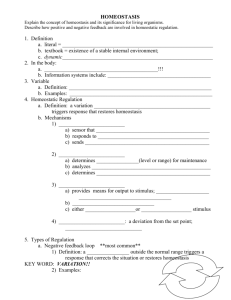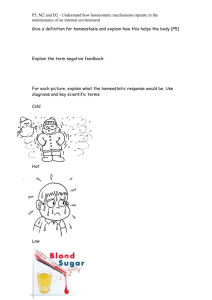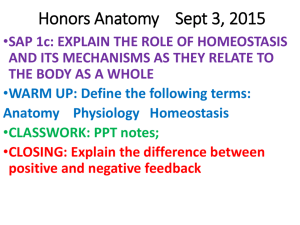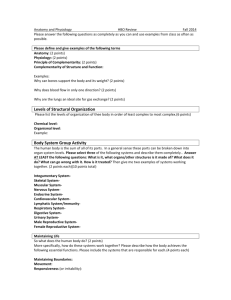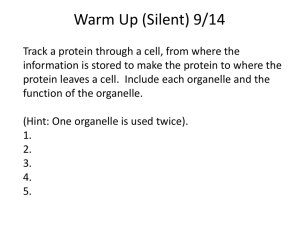Homeostatioc regulation
advertisement
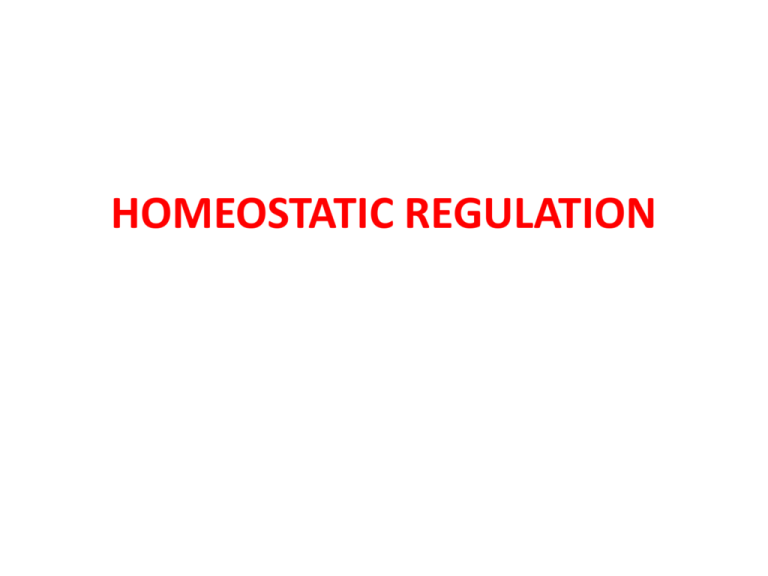
HOMEOSTATIC REGULATION • Objectives: This lecture will introduce the course by providing an overview to the discipline of physiology, giving particular emphasis to the concept of homeostasis and control theory. After completion of this topic, students should be able to: • 1. Explain the concept of a stable internal environment and explain its importance. • 2. Define homeostasis, and be able to give several examples of homeostatic variables and how they are controlled. • 3. Differentiate between negative and positive feedback systems, being able to list the component parts of, and to give several examples of each. • 4. Distinguish between the conditions of equilibrium and steady state. • 5. Define redundancy and feed-forward regulation . • Organ Systems in Review The integration between systems of the body External and Internal Environments “all the vital mechanisms, however varied they may be, have only one object, that of preserving constant the conditions of life in the internal environment.” Claude Bernard (1857) • The Basis of Physiological Regulation • A Stable Internal Environment Is Essential for Normal Cell Function Environments Variable Outside Inside Temperature -10 and +40 °C 37 °C PO2 160 mm Hg PaO2 95 mm Hg PCO2 0.23 mm Hg 40 mm Hg pH ?/variable pH 7.4 stability of the internal environment is the primary condition for a free and independent existence-By controlling its internal environment the organism is no longer at the mercy of the environment Body Fluid Compartments and their Relationship Blood Plasma 3L Interstitial 11 L Intracellular 28 L Body Transcellular 1L •most cases substances within the plasma must pass through the interstitial fluid before entering cells. •Therefore the interrelationships between these 4 compartments are crucial in underlying whole body homeostasis. Body Fluid Constituents Plasma [Na+] = 142 [K+] = 4.4 [Cl-] = 102 [Protein] = 1 Osmolality 290 mOsm Interstitial [Na+] = 145 [K+] = 4.5 [Cl-] = 116 [Protein] = 0 mM Osmolality 290 mOsm Cellular [Na+] = 15 [K+] = 120 [Cl-] = 20 [Protein] = 4 Osmolality 290 mOsm •substances aren’t in equilibrium, but there is a balance there is a difference between the basic constituents of the body-fluid compartments. This means that homeostasis is not about reaching equilibrium, but about maintaining a steadystate. Since the system is not necessarily in equilibrium energy expenditure is required to maintain a steady state. To summarize: Homeostasis is the maintenance of a steady state of the internal environment of the body. 9 Homeostatic control mechanisms Feedback( flow of information along a closed loop )– Negative or Positive • Negative – change is sensed and action taken to prevent further change e.gregulation of secretion of hormones. • Positive – change is sensed and action taken to amplify change (usually associated with a discrete end point, e.g. birth, ovulation) Homeostatic Mechanisms • Most homeostatic mechanisms are based on negative feedback • specific terms that are used to describe the processes involvedControlled Variable Sensor Comparator, set point Effectors Blood Pressure Regulation Blood Loss Blood Pressure (controlled variable) Baroreceptor (sensor) Vasoconstriction ↑ Cardiac Output (effectors) Brain (comparitor) Cardiovascular control center – compares BP to set point and adjusts vascular tone and cardiac output accordingly Blood Glucose -ve Feedback b-cell Insulin secretion Variable Blood Glucose Glucose Cells b-cell “Gain” of a Control System • The degree of effectiveness with which a control system maintains constant, conditions is determined by the gain of the negative feedback. • For instance, let us assume that a large volume of blood is transfused into a person whose baroreceptor pressure control system is not functioning, and the arterial pressure rises from the normal level of 100 mm Hg up to 175 mm Hg. • Then, let us assume that the same volume of blood is injected into the same person when the baroreceptor system is functioning, and this time the pressure increases only 25 mm Hg. Thus, the feedback control system has caused a “correction” of –50 mm Hg—that is, from 175 mm Hg to 125 mm Hg. There remains an increase in pressure of +25 mm Hg, called the “error,” which means that the control system is not 100 per cent effective in preventing change. Q Assume that excess blood is transfused into a patient whose arterial baroreceptors are nonfunctional and blood pressure increases from 100 to 150 mm Hg. Then, assume that the same volume is blood is infused into the same patient under conditions where his arterial baroreceptors are functioning normally and blood pressure increases from 100 to 125 mm Hg. What is the approximate feedback “gain” of the arterial baroreceptors in this patient when they are functioning normally? A) -1.0 B) -2.0 C) 0.0 D) +1.0 E) +2.0 Positive Feedback • This is when instead of the comparator causing the controlled variable to come back to normal it potentiates the error signal and the controlled variable moves further away. • There are few normal physiological events that are controlled by positive feedback. Positive Feedback All steps in this process produce an increase in the next step leading to a loop of stimulation. The positive feedback loop is broken when the baby is expelled from the uterus and hence the step involving pressure against the cervix has been removed. Contraction oxytocin Feed-forward Control • Anticipation of change – gets the body ready for change • e.g. heart rate and ventilation can increase even before exercise begins • Or salivation and digestive enzyme production begins before a meal is eaten Redundancy • Homeostatic mechanisms are important – therefore often there is more than one control mechanism • If one mechanism fails – then there is a backup system (e.g. control of cutaneous blood vessels by both cardiovascular control center and temperature control center, or blood pressure) Hypovolemic Shock B.P. falls Angiotensinogen in blood Renin Kidney Juxtaglomerular cells Aortic arch Carotid sinus Activity drop Angiotensin I Hypothalamus Posterior Pituitary ACE Medulla oblongata Sympathetic output ADH Angiotenin II LUNG Adrenal Cortex Kidney Salt water conservation Blood Vessels Heart rate contractility Aldosterone Inc. vasc. resistance Inc. volume Inc. B.P. In response to a bacterial infection my body's thermostat is raised. I start to shiver and produce more body heat. When my body temperature reaches 101 degrees, I stop shivering and my body temperature stops going up. This is an example of: A) Negative feedback B) A malfunctioning control system C) Positive feedback D) A negative impact Which of the following is an example of a positive feedback? A) Shivering to warm up in a cold winter storm B) A cruise control set on your car applies more gas when going up a hill C) You sweat on a hot summer's day and the blood vessels in your skin vasodilate D) You get cut and platelets form a clot. This in turn activates the fibrin clotting system and more blood forms clots Where is the body's "thermostat" found? A) Within the nervous system, in the Hypothalamus B) Within the integumentary system, in the skin C) Within the brain, in the corpus callosum D) Within the Urinary system, in the kidneys What system has little to contribute to the homeostasis of the organism? A) Urinary System B) Reproductive System C) Respiratory System D) Nervous System Summary I • Homeostasis – maintenance of a stable internal environment • Steady state – unchanging with time • Equilibrium – when parameters are maintained in an energetically favorable situation • Redundancy – more than 1 system to control a variable (backup systems) Summary II • Negative feedback – feedback causes a perturbation to be minimized or reversed with view to keeping parameter at a set point • Positive feedback – amplification of a deviation (usually defined end point)
